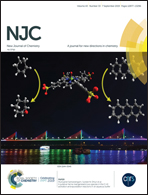Synthesis, characterization, photoluminescence and intensity parameters of high quantum efficiency pure-red emitting Eu(iii) fluorinated β-diketone complexes†
Abstract
The high quantum efficiency mononuclear seven-, eight- and nine-coordinate Eu(III) complexes and their lanthanum analogues [Ln(fod)3B] (where Ln is La and Eu, fod is the anion of 5,5,6,6,7,7,7-heptafluoro-2,2-dimethyl-3,5-octanedione, and B is 1H-indazole (1), 2-(1H-imidazol-2-yl)pyridine, impy (2) and 2,4,6-tris(2-pyridyl)-s-triazine, tptz (3)) have been synthesized and thoroughly characterized. The absence of ligand fluorescence and phosphorescence in these complexes even in chloroform solution reflects the efficient energy transfer from the selected chromophores to Eu(III) ion. Based on the emission spectra, different luminescence parameters like radiative lifetime, radiative and non-radiative rate constants, quantum efficiencies (intrinsic quantum yields) and CIE coordinates have been calculated, analyzed and compared to other reported values in the literature. The quantum efficiency of the present complexes is high (up to 60.61%). The eight-coordinate complex has higher quantum efficiency than the seven- and nine-coordinate complexes. The high quantum efficiency of complex 2 reflects the dominance of the radiative deactivation pathway in the inner as well as outer coordination spheres of Eu(III). The nine-coordinate complex of tptz (3), interestingly, is more luminescent than the seven-coordinate complex (1). Though complex 1 is more asymmetric (higher R value), its relatively lower quantum efficiency might be due to (i) the presence of N–H oscillators that favors the non-radiative deactivation processes over radiative ones and (ii) the poor overlapping between higher triplet state of indazole and emitting state of Eu. The higher values of Ω2 observed for these complexes specify high polarizability, relatively increased covalent character and dominant nature of hypersensitive transition.



 Please wait while we load your content...
Please wait while we load your content...